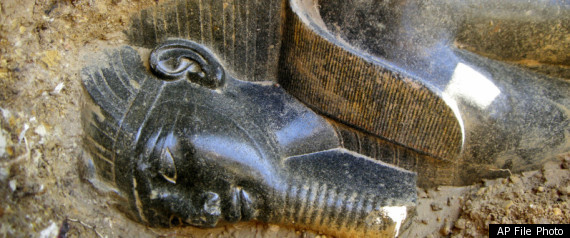The sword with remains of the scabbard on it. Photo: Clara Amit, courtesy of the Israel Antiquities Authority
A sword used by a Roman soldier during the brutal pacification of the Jews and the destruction of the Temple at Jerusalem nearly 2,000 years ago, has emerged from an ancient drainage tunnel beneath the city, Israeli authorities announced this week.
Excavated since 2007, the tunnel, which was used by Jewish rebels as a hiding place from the Romans, has also yielded a stone object adorned with a rare engraving of a menorah, the seven-branched temple candelabra that was the symbol of ancient Judaism.
The 60-centimetre (23.6-inches) long weapon, still in its leather scabbard, is the third Roman sword found in Jerusalem.
BLOG: Ancient Roman Map Puzzle May Get New Pieces
What makes the finding unique is the fine state of preservation, said the excavation directors Eli Shukron of the Israel Antiquities Authority and Ronny Reich of the University of Haifa.
"It seems that the sword belonged to an infantryman of the Roman garrison stationed in Israel at the outbreak of the Great Revolt against the Romans in 66 AD," the researchers said in a statement.
At that time, the Jewish people revolted against the tyranny of Rome, but despite a remarkable resistance, they were ultimately crushed.
Big PIC: King Herod's Palace Contained Luxury Theater Box
The Romans also destroyed the second Temple, which, according to Jewish tradition, was built by King Herod the Great on the site of King Solomon’s temple. This was razed by the Babylonians around 587 BC.
In 70 AD, the Romans under Titus plundered tons of gold, silver trumpets and gold candelabra from Herod’s magnificent white-and-gold temple. Then they paraded the treasure, which also helped finance the building of the Colosseum, through the streets of Rome in triumph.
The stone engraved with the image of the menorah. Courtesy of Vladimir Naykhi
The moment was captured in a frieze carved into the Arch of Titus, which clearly shows the menorah, the seven-branched temple candelabra, being exposed through the streets.
The menorah was also recorded in a stone object unearthed near the Temple Mount.
"Interestingly, even though we are dealing with a depiction of the seven-branched candelabrum, only five branches appear here. The portrayal of the menorah’s base is extremely important because it clarifies what the base of the original menorah looked like, which was apparently tripod shaped," the researchers said.
The fact that the stone object was found near the Temple Mount would suggest that it belonged to a passerby who saw the menorah with his own eyes.
"Amazed by its beauty, he incised his impressions on a stone and afterwards tossed his scrawling to the side of the road, without imagining that his creation would be found 2,000 years later," the researchers said.















